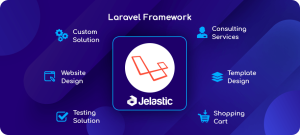Mastering Cross-Platform App Development with React Native: A Comprehensive Guide by Jain Software
In Business, Official BlogIn view of the dynamic nature of today’s digital world, faster than ever mobile app development is an indispensable part of business which tries to succeed. As demand for apps on multiple platforms grows, the developer now has to deal with the tough job of building excellent apps that suit users various tastes, but still ensuring the applications are ready to market in the stipulated time and at reduced cost. This is where cross-platform app development with the assistance of frameworks like React Native becomes extremely beneficial. These special frameworks help developers build programs that operate on both IOS and Android platforms without a hitch.
Realizing how vital it is to make use of advanced technologies in order to help our clients get top-notched solutions at Jain Software, we are always there to provide them with these solutions. This cross-platform app development with React Native guide is written in such a way that we take a peek into the world of cross-platform app development, analyze its features, benefits and disclose the best practices that will help you to create cross-platform apps like a real pro.
Understanding React Native
React Native is an open-air structure which was set up by Facebook and serves as a platform for mobile application developers to build interactive applications similar to native ones using React and Javascript. In the context of React Native hybrid framework, we have one more benefit, this provides the environment of real native app which can work in performance and user experience as good as an app which is developed by native development languages like Java or Swift.
It is one of the significant merits of React that underpins cross-platform code reusability as it cannot only streamline the time and work for the developers but also gives them the opportunity to use multiple types of operating systems. The advantage of using a single concept is the ability to concurrently target both platforms. Doing so leads to a bigger audience and to the app occupying an even more prominent position on those platforms.
Using React Native As a Cross-Platform App Development Platform Is Bringing in Some Benefits.
Faster Development Time: One of the major benefits of react native with this framework, developers can write code only once and launch it across several platforms at the same time, eliminating the need to have two different codebases for two mobile operating systems – iOS and Android. An outcome is that the development cycle becomes more rigid and the time-to-market shortens whilst development costs decline.
Native-Like Performance: Using react native, you can create applications that behave like native apps and feel fast and fluid to use no matter your background in mobile application development. The React Native apps use inherent interface properties and APIs that produce smooth animations, skillful touch interactions, and hassle-free navigation.
Hot Reloading: React Native’s so-called “hot reloading” feature allows program engineers to observe the results of their code updates in real-time, without the need to rebuild an entire application. That successive creating cycle is improving output and makes possible the materializing and testing operations much faster.
Large Developer Community: What makes React Native stand out are the large and vibrant developer community while offering many resources, libraries and plugins that can accelerate and facilitate the designer process. As with third party integrations and UI components, application developers can leverage from existing assets and quicken the app development and add functionality.
Cross-Platform Compatibility: React Native provides the tools for the development of cross-platform apps suited for optimal rendering on iOS and Android devices which gives a homogenous experience for users irrespective of the platform they are using. This flexibility allows businesses to cover an array of topics ranging from each end without steering the topic away from the quality and effectiveness part.
Best Practices of the React Native Utilization for the Development of Multipurpose Apps.
Follow Platform-Specific Guidelines: Although React Native helps to reach the aim of code-sharing between these operative systems, it is recommended also to follow platform-specific design and development rules to avoid performance issues and to make your app usable to the maximum. Get to grips with iOS Human Interface Guidelines and Android Material Design principles. This way you’ll be able to develop native-like interfaces.
Optimize Performance: It is crucial that you examine the performance improvement strategies well keeping in mind that your React Native app works fine on all devices. Meaning minimize rendering times, optimize and implement assets and lazy loading as well as code splitting for improving app performance an reduce loading times in the overall.
Use Native Modules and APIs: Tap into the native functionality of React Native using its capability to integrate with native modules and APIs so you can access the platform specific functionalities on purpose. Often, the native features can be about the app sensors, its native built-in navigation components or the integration with the third-party SDKs. This is the way to make the app more functional and enjoyable for the user.
Test Across Multiple Devices: Keep on trying the app in all devices, various screen sizes, and for consistency. Embrace testing frameworks such as Jest and Enzyme for unit testing and instruments such as Appium or Detox for accepting mode testing to make out any problems at a first step in the development.
Monitor and Optimize App Performance: Use FPS monitoring platform such as React Native Performance Monitor or Firebase Performance Monitoring to observe critical performance indicators and spots for performance enhancement. Continuously analyze app performance, employ user feedback along with iteration to improve user experience and deliver a stellar one.
Conclusion
React Native, the hugely capable framework, brings power to developers on how to build apps that have cross-platform quality on a single code repository. Using its capabilities and following a proper development procedure, the developers will be able to create native apps with all features, which will run on the both iOS and Android operating systems. Such apps will be used by a large number of people, and, as a result of this, the app will have a great success.
And Jain Software is devoted to being tech-edge with our kind of innovation endeavors meant for addressing our client needs. Whether you are a startup aiming at building a mobile app or an enterprise looking to extend your digital capacity, our team of highly-experienced developers exists to ensure you face no challenge in folding your React-Native application with ease. Drop in and talk with us right away to learn more about our services, and how we can together bring your app idea into reality.











